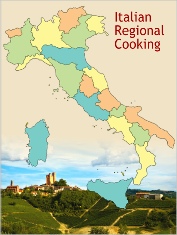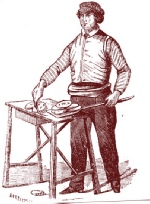







JOIN NOW
our Italian Cooking
Newsletter
our Italian Cooking
Newsletter

Publication or use of pictures, recipes, articles, or any other material form my Web site, on or off-line without written permission from the author is prohibited. If you would like to use my articles on your Web site or in your publication, contact me for details. Avoid infringing copyright law and its consequences: read the article 7 Online Copyright Myths by Judith Kallos
Read our
DISCLAIMER and
PRIVACY POLICY
before using
our site
-------------------
Linking Policy
Advertise with us
DISCLAIMER and
PRIVACY POLICY
before using
our site
-
Advertise with us
Copyright © 2003 - 2011 Anna Maria Volpi - All Rights reserved.
Anna Maria's Open Kitchen Site Map
site map
recipes
policies
about us
Some More Hot Topics You'd Like to See adv.




Anna Maria Suggests
Extra-
The Best Selection of Italian Extra-
Buy from the source Authentic Aged Traditional Balsamic Vinegar from Italy
Sicily, Apulia, Lazio, Liguria, and More...The Best Selection of Succulent Italian Olives Oil
Infused Extra-
Spice up your dishes with Infused Flavored Italian Extra-
A Brief History of Pizza
Pizza, as we know it today, derives from focaccia, flat bread that has been prepared since antiquity in different forms and garnished with herbs, olives, fat, raisins, honey, and nuts. In fact, the word “pizza” in Italian identifies any type of flat bread or pie that is fried or baked.
Although you can find many types of pitas or pizzas around the Mediterranean, it is in Naples, after the tomato appeared on the table in the 1700s, that pizza first emerged in the form we know today.
Naples has records of pizza since around the year 1000. The first records call these flat breads laganae, and later they are referred to as picea. In those times, pizzas was dressed with garlic and olive oil, or cheese and anchovies or small local fish. They were baked on an open fire and sometimes were closed in half, like a book, to form a calzone.
Naples is also where the first pizzerias opened. They had brick wood-burning ovens covered with lava stones from mount Vesuvius. The chefs of those times ignored pizza because it was considered a poor man’s food. Yet the introduction of tomato into the combination around the 1770s must have raised some curiosity even in the royal palace.
Ferdinand I Bourbon, King of Naples, loved the simple food of the people and went to taste pizzas made in the shop of Antonio Testa. He liked them so much that he wanted pizza included in the menu at the court. He failed after the opposition of his wife, Queen Maria Carolina. His son Ferdinand II also liked all kinds of popular foods. He loved pizza so much that he hired Domenico Testa, son of the now famous Antonio, to build a pizza oven in the royal palace of Capodimonte.
Pizza became very popular, earning its place in Neapolitan folklore. Simple and economical, it turned into a food for everyone, even sold on the streets, as shown in many illustrations of the time.
A famous episode extended the popularity of pizza beyond the limits of the city of Naples. It was 1889, and Margherita, queen of Italy, was visiting the city. She was told about pizza and wanted a taste. A famous cook named Don Raffaele, with the help of his wife Donna Rosa, was invited to cook pizza at the royal palace.
They prepared three pizzas typical of that time. One was with cheese and basil; one with garlic, oil, and tomato; and one with mozzarella, basil, and tomato. The queen, impressed by the colors of the last pizza, which resembled the national flag, preferred that one. Since then, this pizza has been known as Pizza Margherita, and Don Raffaele is credited with its invention, even though we know today that it had already existed even then for a long time.
At the beginning of the last century, Italian immigrants opened the first pizzerias in the United States, where pizza has become a mass phenomenon. Yet, even today the best pizza is found in Naples, where it is rigorously made with buffalo mozzarella.
Superior pizzas are considered those obtained by moderate variations of the simplest and most popular: Pizza Napoletana with tomato, garlic, oil, and oregano; Pizza Margherita; Pizza Marinara with tomato, anchovies, capers, and olives; and Pizza Four Seasons, divided in four quadrants, each dressed in a different way. Pizza with hot salami, the American pepperoni pizza, is instead found in the Calabria region south of Naples, where this type of hot sausage is produced.
Anna Maria Volpi
© Annamariavolpi.com
Pizza, as we know it today, derives from focaccia, flat bread that has been prepared since antiquity in different forms and garnished with herbs, olives, fat, raisins, honey, and nuts. In fact, the word “pizza” in Italian identifies any type of flat bread or pie that is fried or baked.
Although you can find many types of pitas or pizzas around the Mediterranean, it is in Naples, after the tomato appeared on the table in the 1700s, that pizza first emerged in the form we know today.
Naples has records of pizza since around the year 1000. The first records call these flat breads laganae, and later they are referred to as picea. In those times, pizzas was dressed with garlic and olive oil, or cheese and anchovies or small local fish. They were baked on an open fire and sometimes were closed in half, like a book, to form a calzone.
Naples is also where the first pizzerias opened. They had brick wood-
Ferdinand I Bourbon, King of Naples, loved the simple food of the people and went to taste pizzas made in the shop of Antonio Testa. He liked them so much that he wanted pizza included in the menu at the court. He failed after the opposition of his wife, Queen Maria Carolina. His son Ferdinand II also liked all kinds of popular foods. He loved pizza so much that he hired Domenico Testa, son of the now famous Antonio, to build a pizza oven in the royal palace of Capodimonte.
Pizza became very popular, earning its place in Neapolitan folklore. Simple and economical, it turned into a food for everyone, even sold on the streets, as shown in many illustrations of the time.
A famous episode extended the popularity of pizza beyond the limits of the city of Naples. It was 1889, and Margherita, queen of Italy, was visiting the city. She was told about pizza and wanted a taste. A famous cook named Don Raffaele, with the help of his wife Donna Rosa, was invited to cook pizza at the royal palace.
They prepared three pizzas typical of that time. One was with cheese and basil; one with garlic, oil, and tomato; and one with mozzarella, basil, and tomato. The queen, impressed by the colors of the last pizza, which resembled the national flag, preferred that one. Since then, this pizza has been known as Pizza Margherita, and Don Raffaele is credited with its invention, even though we know today that it had already existed even then for a long time.
At the beginning of the last century, Italian immigrants opened the first pizzerias in the United States, where pizza has become a mass phenomenon. Yet, even today the best pizza is found in Naples, where it is rigorously made with buffalo mozzarella.
Superior pizzas are considered those obtained by moderate variations of the simplest and most popular: Pizza Napoletana with tomato, garlic, oil, and oregano; Pizza Margherita; Pizza Marinara with tomato, anchovies, capers, and olives; and Pizza Four Seasons, divided in four quadrants, each dressed in a different way. Pizza with hot salami, the American pepperoni pizza, is instead found in the Calabria region south of Naples, where this type of hot sausage is produced.
Anna Maria Volpi
© Annamariavolpi.com
Pizza seller in the streets of Naples, engraving, early 1800s. The tradition of preparing and selling all kinds of pizzas in the streets remains well and alive today in the small lanes of downtown Naples. Pizza and calzoni, panzerotti, and pizzelle fritte are delicious when eaten warm - prepared right on the spot - in hundreds of small shops. As with fast foods, they can be either a snack or a full meal.

Pizza!
Pizza in restaurants is cooked in wood-burning ovens at a very high temperature for about 10 minutes. In fact, pizza should stay in the oven for the shortest time possible to prevent it from drying too much. The smoke of the wood also gives pizza a distinctive flavor. It is impossible to reproduce perfectly the same conditions at home, but with my step-by-step recipe, you will be able to make an excellent pizza at home.

You have seen the chefs on TV twisting and swirling their pizza dough in the air. You have eaten pizza at restaurants hundreds of times. If you think it’s impossible to make a good pizza in your oven, I will change your mind.
Pizza!






